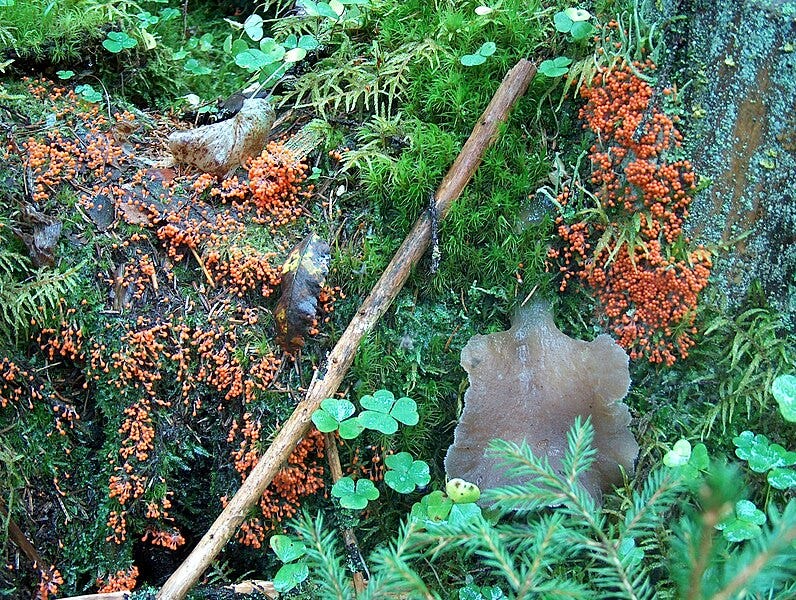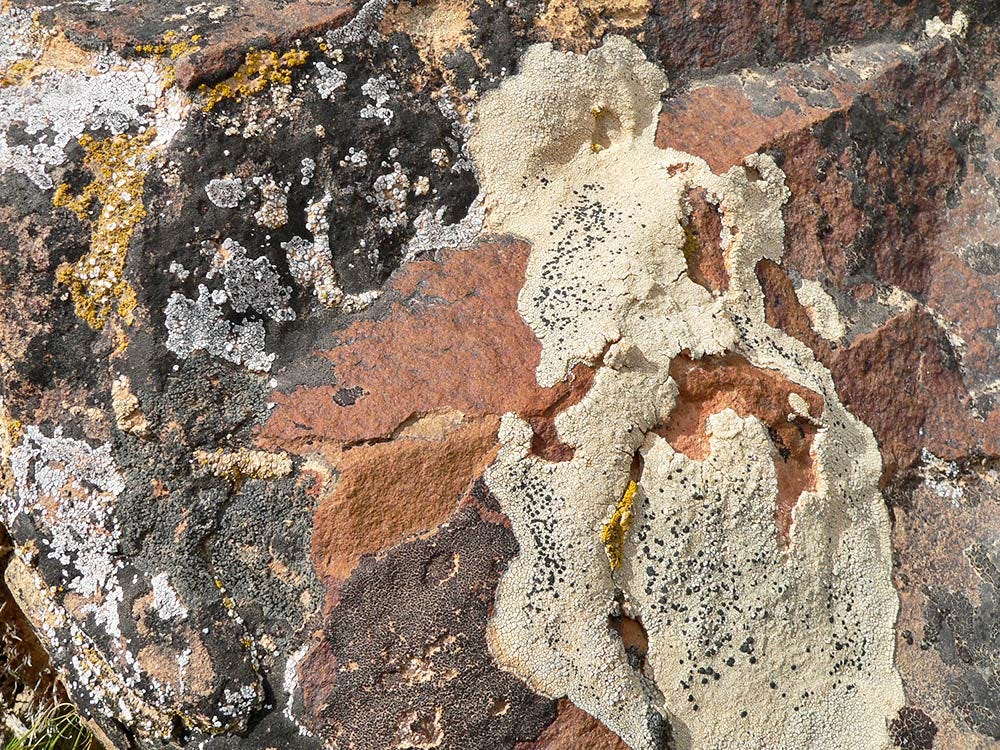
Let’s start with the slime mold. It’s not an animal, it’s not a plant, it’s not a fungus – and it has a totally ridiculous name. When one looks at macro images, slime is the last thing that comes to mind – especially in their fruiting stage, when they bear bodies filled with spores, they look absolutely stunning and otherworldly. Here are some gorgeous award-winning images.
Because a true mold is a fungus, that part of the name isn’t really correct, either. Most slime molds are amoeba-like single-celled organisms which at a certain stage of their life cycle fuse together and grow into a structure resembling interlaced tubes which slowly moves (without feet), searching for food. They can grow 10 to 13 feet long, and some species have covered over 35 square yards!
I’ll write about only one of the two kinds of slime mold, the one which is visible to the naked eye. They’re called acellular or plasmodial, whereas most organisms of the other type, the cellular slime mold, are microscopic. The plasmodial class of slime molds is called Myxogastria or Myxomycetes.

Plasmodial slime molds, just like the cellular ones, start out as individual amoeboid cells, but then they join together, forming something like a “super-cell” because they have only one cellular membrane but many nuclei. This metamorphosis is often triggered by environmental factors such as the availability of food. When they get hungry, they bond with each other because their chances to find nutrients are multiplied. They can be found on coarse woody debris, ground litter, tree bark, and other damp shady habitats where they feed on bacteria, yeast, and fungi, cleaning up rotting wood and decaying forest litter, thus recycling nutrients in the food web.
What is truly amazing about them is the fact that they can solve problems without having a brain. Scientists discovered that they can quickly find the shortest way out of a maze in order to find a food source. In the laboratory, experiments showed that slime molds could easily find the optimal route between different locations. For example, researchers had slime molds recreate the Tokyo subway system!
Please watch the YouTube video below:
How can the plasmodium eat without a mouth? Move without feet? And, most curiously, make efficient decisions, solve complex problems, and avoid obstacles – without a brain and central nervous system?
Slime molds have a number of tools at their disposal that defy the anthropocentric notion that many scientists have, namely, that only brains (better make that human brains) can make intelligent decisions. For example, slime molds are highly sensitive to chemical signals. They can sense potential food sources and move towards them, or they sense obstacles which they then avoid. They’re sensitive to light, without having eyes. They prefer dark, moist environments which are better suited for their survival.
How they can quickly find the shortest way through intricate labyrinths by exploring several paths and then deciding on the most efficient and direct route is something of a mystery. “They’re evolutionary head-scratchers”, somebody said in the video above. But scientists are recognizing that there are other ways of intelligence beyond the traditional central nervous system/brain setup.
Next, let’s take a look at lichen. They’re rather peculiar fellows, too – neither animal or plant, not a single organism, but a symbiotic partnership between a fungus and algae and/or cyanobacteria. The main partner is the fungus which gives the lichen its shape and its fruiting bodies. It provides protection, water, and nutrients for the secondary partner(s), algae or cyanobacteria (some lichen are host for both), called photobiont. It provides the fungus with simple sugars as a carbon source via photosynthesis. The type of symbiosis between these entities is called mutualism because they all benefit from the relationship.
In 2016, the lichenologist Toby Spribille discovered a THIRD partner in some lichens. Together with biologist John McCutcheon he analyzed DNA sequences for years, to find out why two lichen which seemed different (one is yellow and is poisonous, the other is brown and lacks the toxin) had the same fungus, partnered with the same alga. After literally years of testing, Spribille finally found the hidden fungal partner: a yeast. The toxin in the poisonous lichen is vulpinic acid, and scientists assume that the third, poison-producing partner acts as a repellent and protects the lichen from grazing herbivores such as deer and elk.
Here are a few of the amazing facts about lichens. They cover about 7% of the Earth’s surface and survive in deserts, on rocks, and even inside rocks. They absorb pollutants from the atmosphere, cleaning the air. Scientists use them to evaluate air quality because lichen are sensitive to pollutants such as sulfur and heavy metals which can slow their growth and even kill them. Obviously, northern New Mexico where I took the lichen photos has excellent air, because lichen are ubiquitous. Hummingbirds use them to build their nests! Lichen break down the surfaces of rocks, thereby producing soil. Some are edible; I believe Japanese zen monks use them in their cooking.
I became intrigued by both slime molds and lichen when I read about them in Merlin Sheldrake’s book Entangled Life. If you haven’t read it, I highly recommend you do so, not only because of the fascinating content, but also because of the fact that Sheldrake represents a new kind of scientist.
Classical scientific definitions of intelligence use humans as a yardstick by which all other species are measured. … We are ecosystems, composed of – and decomposed by – an ecology of microbes, the significance of which is only now coming to light.
he writes.
Classical scientific methodology employs a hierarchical, from-the-top-down vertical model which also dominates much of human culture in general, including politics. It is an outdated, actively destructive worldview which puts human wants and needs first, without realizing that human beings exist within a symbiotic relationship between countless other beings. Climate change makes this obvious, although there are still many influential people who deny or ignore this. And many people who take this threat seriously work on the symptoms, not on the cause. Knowing that there are scientists such as Sheldrake who actively promote a different worldview, who recognize the interconnectivity between larger and smaller beings (it’s such a relative notion to begin with) gives me some hope.
All lichen images by Jessica Rath.










Jessica, so excited to see your post!
As I started to read I intended to tell you about Merlin’s fabulous book 📕 ENTANGLED LIFE.
Glad you already read it.
Going to restack this now… 😉
Really absolutely fascinating.